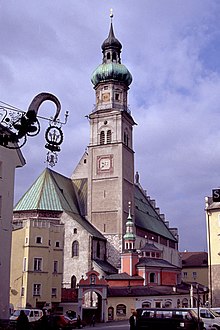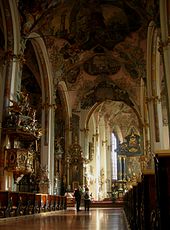City parish church Hall in Tirol
The Roman Catholic parish church of St. Nikolaus is located on the upper town square in the old town of Hall in Tirol ( Austria ).
history
In 1281 a church dedicated to St. Nicholas and St. Ingenuin mentioned in a document in Hall. However, since the church was too small for the up-and-coming salt town , it was rebuilt and expanded in 1352. In the same year the church also received the right to baptize, but was still dependent on the mother parish Absam . However, since the Absamer pastor lived in the town of Hall from 1413 and the number of inhabitants increased sharply in the 15th century, the church was expanded again and received its current Gothic appearance. In the period from 1420 to 1440, the Hall builder Hans Sewer converted the single-nave nave into a three-nave church. Because the building could not be extended to the south and the old choir was retained in the core, the presbytery now appears to be bent.
The church was renovated for the first time at the end of the 16th century. During the severe earthquake on July 17, 1670 , the tower of the parish church collapsed, but was rebuilt in baroque style by 1676 . In the second half of the 17th century, the baroque style of the entire church began. In a fire in 1875 the roof was partially destroyed, the roof and on the gable standing of the west facade statue of St. Nicholas had to be renewed in a row. The ceiling paintings were renovated twice in the 20th century.
Choir room
The main image of the choir vault shows the city of Hall under the protection of the Virgin Mary and numerous saints. This representation is surrounded by pictures of the four occidental church fathers ( Gregory , Hieronymus , Augustine and Ambrosius ).
The painting of the baroque high altar is by the Flemish painter Jan Erasmus Quellinus . He created the work in 1657 when he stopped in Hall on a trip to Italy. The picture shows the seated Mother of God Mary with the baby Jesus surrounded by angels, the martyrs Stephen and Laurentius , St. Kassian and the church patron Nikolaus . The altar is rebuilt at the respective festive times so that a figure of the risen Christ is set up at Easter , a picture of the Annunciation to Mary in Advent and a wooden crib at Christmas .
In a niche on the north wall of the presbytery there is a large Renaissance - Epitaph family Fieger, which was created by the artist Melchior Ritterl in 1574th Below is a panel painting “ Ecce homo ” (around 1510), which is attributed to the Hall painter Sebastian Frosch.
Longhouse
The baroque wall and ceiling paintings that span the nave and give the church its special character were created by the Vienna- born painter Josef Adam Mölk in 1752. The four large ceiling paintings in the main nave show scenes from the life of the patron saint of St. Nicholas.
At the triumphal arch in the front part of the nave, three side altars were built by the sculptor Gregor Fritz around 1754 . The north cross altar shows a plastic crucifixion group, in front of it a picture of the Sacred Heart is placed. On the painting by Josef Adam Mölk of the southern apostle altar the handing over of the key to Peter is shown. Next to it is the Johannes Altar with the Barrel Madonna, a radiant wreath Madonna on the crescent moon, donated by the barrel makers' guild.
In the north aisle are the Waldaufkapelle and the Katharinen altar (around 1740) with several reliquary shrines . In the south aisle is the altar of St. John Nepomuk , who was created in Theodoro Benedetti's workshop as early as 1734 - five years after his canonization. There is also a carved statue of St. Josef can be seen with the baby Jesus by Franz Stöckl (1730). In both side aisles there are guild poles that are still carried during processions today.
The Stations of the Cross by the Schwaz artist Johann Georg Höttinger (1742) can be seen under the organ gallery. To the right of the main entrance is the baptismal font from the 14th century, to the left of it the holy water font (1506).
organ
The organ with baroque ornaments was built by Franz Köck in 1689 and, after several renovations and new constructions, was replaced in 1999 by a new plant by the Pirchner company ( Steinach am Brenner ), the 50 stops of which were largely installed in the restored case behind the 1689 prospectus .
|
|
|
|
|||||||||||||||||||||||||||||||||||||||||||||||||||||||||||||||||||||||||||||||||||||||||||||||||||||||||||||||||||||||||||||||||||||||||||||||||||||||||||||||||||||||
- Coupling : II / I, III / I, III / II, I / P, II / P, III / P
Exterior view
The Fiegerkapelle is built on the western side of the three-aisled nave, which also forms the entrance area at the main gate. The side facing the upper town square is formed by the Gothic choir, the two-storey sacristy and the 67-meter-high tower with an onion helmet.
On the outside wall of the parish church there are grave tablets for various nobles and nuns of the former Haller women's monastery and Clarissian monastery . There is also a memorial plaque for the Tyrolean freedom fighter Joseph Speckbacher , who died in Hall in 1820, but whose bones were transferred to the Innsbruck Court Church in 1858 , where they rest with Andreas Hofer .
Bells
The bells of the parish church in Hall are tuned to the starting notes of the " Salve Regina ":
- The Holy Cross bell was cast in 1570 by Hans Christoph Löffler for the canceled Haller Damenstift .
- The death knell from 1665 was made by Barthlmä Köttelath.
- Three of the four bells melted down in World War II were replaced by the Grassmayr bell foundry in Innsbruck in 1951 .
- The big bell had to be re-cast after a crack in 2001.
- Old deathdrop.
| volume | Caster | year |
|---|---|---|
| c 1 | Grassmayr | 2001 |
| e 1 | H.Ch. Spoonbill | 1570 |
| g 1 | Grassmayr | 1951 |
| a 1 | ||
| c 2 |
Chapels in and around the church
- The Waldaufkapelle , inaugurated in 1501, was donated by Florian von Waldauf . It is located in the left front area of the nave and houses the large collection of relics of the knight, which was also called "Haller Heiltumsschatz". The founder's family is also buried in the chapel, as is the youth pastor Josef Lambichler, who is very popular among the people of Hall, and whose bones were buried there in 1978.
- The two-story Fiegerkapelle was added to the front of the parish church around 1490. The basement forms a vestibule to the church entrance, in which wall paintings from the 15th century can still be seen. The tombstones indicate the family crypt of the wealthy Fieger family. After the family died out, the crypt was also used as a burial place for the last canonesses of the Haller Damenstift, which was closed in 1783 .
- The Magdalenenkapelle is located east of the parish church. It was probably built around 1320 and was originally two-story. The lower floor facing the Lange Graben was dedicated to St. It was consecrated to James but is now a shop. The upper room houses frescoes from the 15th century (Mary surrounded by saints, three kings and the Last Judgment), as well as a late Gothic winged altar from the church of St. Magdalena in the Halltal . The large oil painting "Adoration of the Lamb" dates from the early 16th century. The chapel has been used as a memorial chapel for those who died in the world wars since 1923.
- The Wolfgang chapel, consecrated in 1505, stood on the place in the northeast of the parish church, where the Josef chapel is located today . It was built by the knight Florian Waldauf in order to display the relics of the Hall healing treasure donated by him once a year for the population. However, the little church was destroyed by the parish church tower, which collapsed in the 1670 earthquake. From 1695 to 1698, today's Josefskapelle was built on this site. On the ceiling paintings and the altar of the chapel there are scenes from the life of St. Josefs depicted.
The legend of the "Haller Kübel"
In the vernacular, the residents of the city of Hall are referred to as "Haller Kübel" (Tyrolean "Håller Kiebl"). This name goes back to an event that is said to have taken place in the parish church. When the statue of Jesus was pulled up on the feast of Ascension, the rope broke and the figure shattered on the church floor. Some tradition-conscious Hallers immediately collected the fragments and put them in a bucket. Finally, the bucket with the broken pieces was pulled into the sky with the words “åber aufi must he” (High German “but he has to go up”).
literature
- Verena Friedrich and Romedio Schmitz-Esser, St. Nikolaus Parish Church and Chapels , Passau 2007
- Philbert Seeböck, History of the St. Nikolaus Parish Church in Hall im Innthale , Innsbruck 1881
Web links
Individual evidence
- ↑ Hall in Tirol, St. Nikolaus parish church on orgeln.musikland-tirol.at, accessed on September 15, 2010
Coordinates: 47 ° 16 ′ 53.5 " N , 11 ° 30 ′ 24" E



